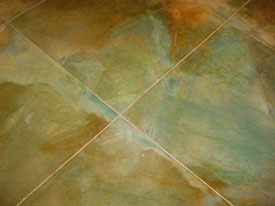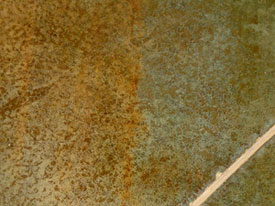 |
||||||
| August 17, 2004
In This Issue of The Acid Staining Newsletter
In the last newsletter I touted the ability of Ultrite Degreaser to remove liquid curing compound from a slab in order to make it stainable. I must have been tempting Fate. The very next week my crew encountered a slab which we were scheduled to stain, but it had curing compound all over it. We had no Ultrite Degreaser on hand, and no time to order it. We turned to our next favorite cure-all - a strong citrus cleaner called De-Zov-All, made by Harvard Chemical Research, Inc. www.hcronline.com We purchase De-Zov-All in five-gallon buckets at a janitorial supply store which carries Harvard products. We have formerly used it with good effect to remove black mastic from slabs—probably the messiest, gooiest thing you will ever have to deal with. After discovering that it melted the tarry mastic, if applied full strength and given 40 minutes to work, we began to use it on floors with paint spots, glue and other contaminants. We found that for these things it was best to dilute it one-to-one with water (it will turn cloudy right away), soak the floor with the diluted mixture and keep it wet for 40 minutes, then scrub with a buffer fitted with a black pad. Keeping our fingers crossed, we used diluted De-Zov-All on our curing compound floor and found that it worked fairly well. It did not get all the way through the compound on the first try, but one or two more soaks and scrubs did the trick. In a day and a half the crew was able to clean 1050 square feet of curing compound. This includes a final scrubbing with TSP solution. You must use TriSodium Phosphate afterwards, since the citrus cleaner itself tends to throw off the stain. TSP cuts through it and makes the slab perfect for staining. The “active ingredient” in these products is called d’limone and Conquer is 100% d’limone. The peels of oranges are squeezed—in
There are probably other good brands of citrus cleaner on the market, but I would advise against getting them at home improvement or paint stores. They sell some diluted versions (tinted orange to make them look stronger), which do not remove anything, as far as we can tell. The real citrus cleaners are fairly clear in color until they are mixed with water. Just before this Newsletter went to press, I got a letter from Keith Miller, a technical rep at Unitex chemicals (www.unitex-chemicals.com). They make a cleaner called Citri-clean which also removes curing compounds. Unitex is in the business of manufacturing curing compounds and has developed one which allows more moisture loss from the slab than past compounds, and which may therefore allow penetration by acid stains. It has been tested by Chris Sullivan at QC Construction products.
Happy Staining! GG Questions or comments about my newsletter? |
||||||
|
|
||||||


